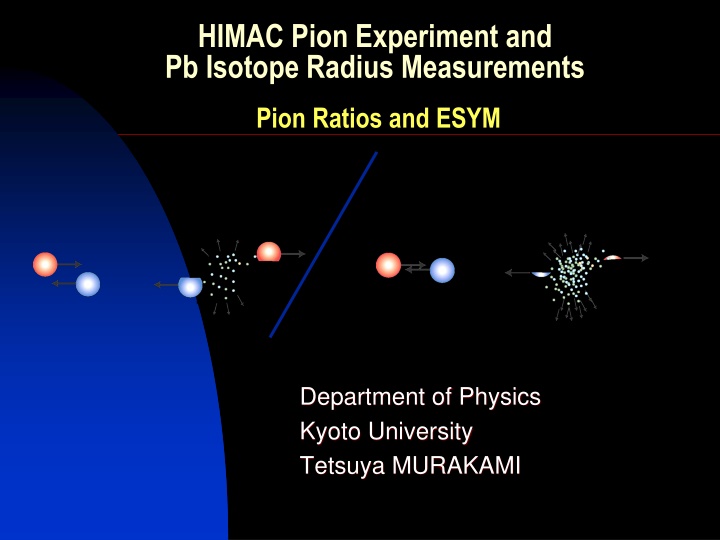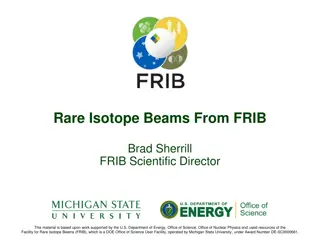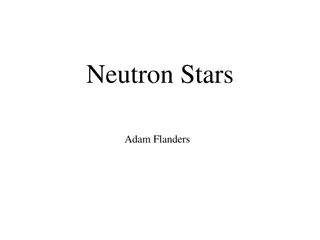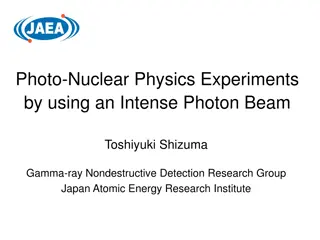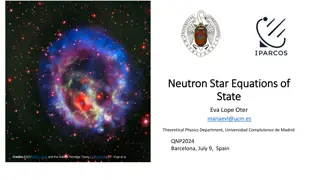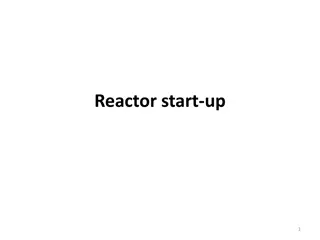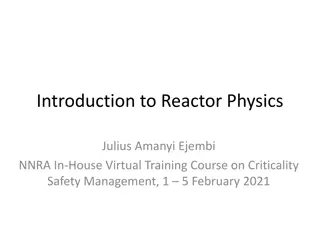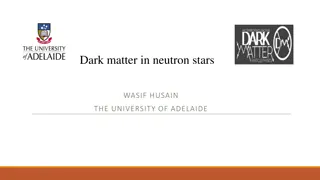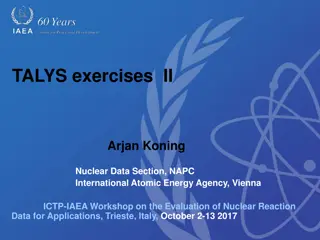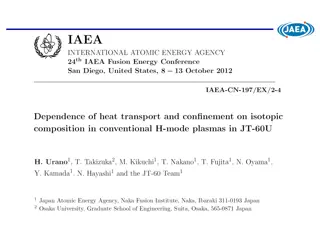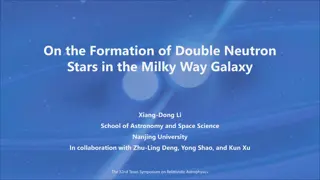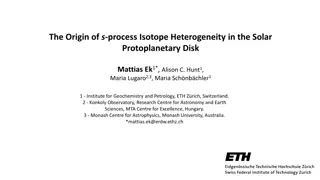Nuclear Physics Research Highlights: Neutron Stars, Nuclear EOS, and Pb Isotope Studies
Explore cutting-edge research in nuclear physics, including experiments on pion ratios and Pb isotope radius measurements, neutron star observations, neutron density distributions of Pb isotopes, and polarized proton beams at Osaka University. Learn about the analysis of realistic point proton density distribution and the development of Relativistic Impulse Approximation. Dive deep into the fascinating world of nuclear science and its implications for our understanding of mass-radius relations and density transitions.
Download Presentation

Please find below an Image/Link to download the presentation.
The content on the website is provided AS IS for your information and personal use only. It may not be sold, licensed, or shared on other websites without obtaining consent from the author.If you encounter any issues during the download, it is possible that the publisher has removed the file from their server.
You are allowed to download the files provided on this website for personal or commercial use, subject to the condition that they are used lawfully. All files are the property of their respective owners.
The content on the website is provided AS IS for your information and personal use only. It may not be sold, licensed, or shared on other websites without obtaining consent from the author.
E N D
Presentation Transcript
HIMAC Pion Experiment and Pb Isotope Radius Measurements Pion Ratios and ESYM Department of Physics Kyoto University Tetsuya MURAKAMI
Neutron Star vs Nuclear EOS Mass Mass High Density High Density Mass Limit Mass Limit Observations of Observations of Mass and Radius Mass and Radius Phase Phase Transition Transition Low Density Low Density Radius Radius MR(Mass-Radius) Relation Tolman Oppenheimer Volkoff equation TOV equation EOS E/A E/A Low Density Low Density Phase Transition ( (nucleon,electron, nucleon,electron, ) ) High Density High Density L ( (nucleon,hyperon nucleon,hyperon, , meson,quark meson,quark) ) Density Density ( ( B B) ) 0 0 2 2 0 0
Useful Notations = ) 0 , + + 2 4 ( , ) ( ( ) ( ) E E E sym K 2 ) 0 , = + + 2 3 0 ( ( ) 0 , 0 ( ) E E K sym 2 = + + + 2 3 ( ) ( ) ( ) E E L 0 sym sym 2 ( ) 0 , 2 E = 2 0 9 K 0 = 0 = ( / ) n p = ( / ) 0 3 0 = ( ) S E 0 sym ( ) E sym = 3 L 0 = 0 2 ( ) E sym = 2 0 9 K sym 2 = 0 6 K K L 3 sym
It started in 2000 from Alex`s paper, PRL85, 5296 (2000) He urged experimentalists to measure a neutron skin thickness of 208Pb precisely. 4 We challenge to ALEX and PREX.
Neutron Density Distributions of Pb Isotopes From J. Zenihiro s PhD thesis 2011 PRC82, 054607 (2010) 5
RCNP, Osaka University Polarized Proton beams of 295 MeV Typical polarization ~75% 6
Analysis Relativistic Impulse Approximation developed by Murdock and Horowittz (MH) Realistic point proton density distribution deduced from electron scattering data Scalar density = 0.96 Vector density Neutron density = Sum of Gaussian 8
( ) rnp fm + 204 . 0 . 0 + 047 059 . 0 178 Pb 206 . 0 . 0 + 048 064 . 0 180 Pb 208 . 0 . 0 054 063 . 0 211 Pb 12
S=33.0 L=67.0 1.1 MeV 12.1 MeV 14
Summary of neutron skin thickness ( ) rnp fm + 204 . 0 . 0 + 047 059 . 0 178 Pb S=33.0 L=67.0 1.1 MeV 12.1 MeV 206 . 0 . 0 + 048 064 . 0 180 Pb 208 . 0 . 0 054 063 . 0 211 Pb Unfortunately, doesn`t look like sufficiently precise. 16
ESPRI (Elastic Scattering of Proton with RI beam) Project One of Future Directions Beam line MWDCs Solid hydrogen target (1mm thick) Large MWDCs for recoil protons Array of 14 NaI(Tl) Array of Silicon Strip Detectors We have measured elastic scatterings on 20O, 9-11C, and 66,70Ni. 17
According to Bao-Ans calculation from NPA 708 (2002) 365. 18
RIBF ? S=33.0 L=67.0 Ksym=-148 1.1 MeV 12.1 MeV 124 MeV GSI MSU Reisdorf, et al., NPA 781 (2007) 459. Xiao, et al., arXiv:0808.0186 (2008) Au+Au Isospin diffusion, n-p flow Pion production
HIMAC Pion Experiments Details will be presented by Mr. Sako tomorrow. Our on-going SAMURAI-TPC project along the same direction will be presented by Dr. Isobe this afternoon. 21
Using Minimum Setup Centrality Filter Multiplicity filter for Charged Particles Portable, If possible. Pion Detector Simple and portable system HIMAC
Performed Experiments Target Beam energy 30deg 45deg 60deg 75deg 90deg 120deg In (Pb) 400 MeV/u 132Xe 2008.11 In 400 MeV/u 28Si 2009.7 (Pb) In 600 MeV/u 28Si 2009.10 (Pb) 800 MeV/u In 28Si 2009.11
Beam Energy Dependence : Si 600 MeV 400 MeV -/ + -/ + Fitting : C*X- log scale log scale 800 MeV -/ + 45deg 60deg 90deg 120deg slope : 400 : (4.5 600 : (3.2 800 : (2.0 0.5) 0.5) 0.5) 10-1 10-1 10-1 log scale Slopes depend on Beam Energy Erap (MeV)
If we are lucky, we are going to measure pions from 129,132,136Xe on CsI reactions at 400 MeV/u in FY2011. come back 25
Members of Collaboration RCNP E248 Collaboration Kyoto University J. Zenihiro, Y. Iwao, H. Sakaguchi, S. Terashima, Y. Yasuda, M. Yosoi Research Center for Nuclear Physics M. Itoh, M. Uchida, H.P. Yoshida HIMAC P226 Collaboration Kyoto University M. Sako, S. Ebesu, Y. Ichikawa, S. Imajo, R. Sameshima Rikkyo University K. Ieki, Y. Ikeda, H. Kawamura, M. Matsushita, J. Murata, M. Nitta, T. Toyoda RIKEN Nishina Center Y. Nakai, S. Nishimura NIRS E. Takada, 26
